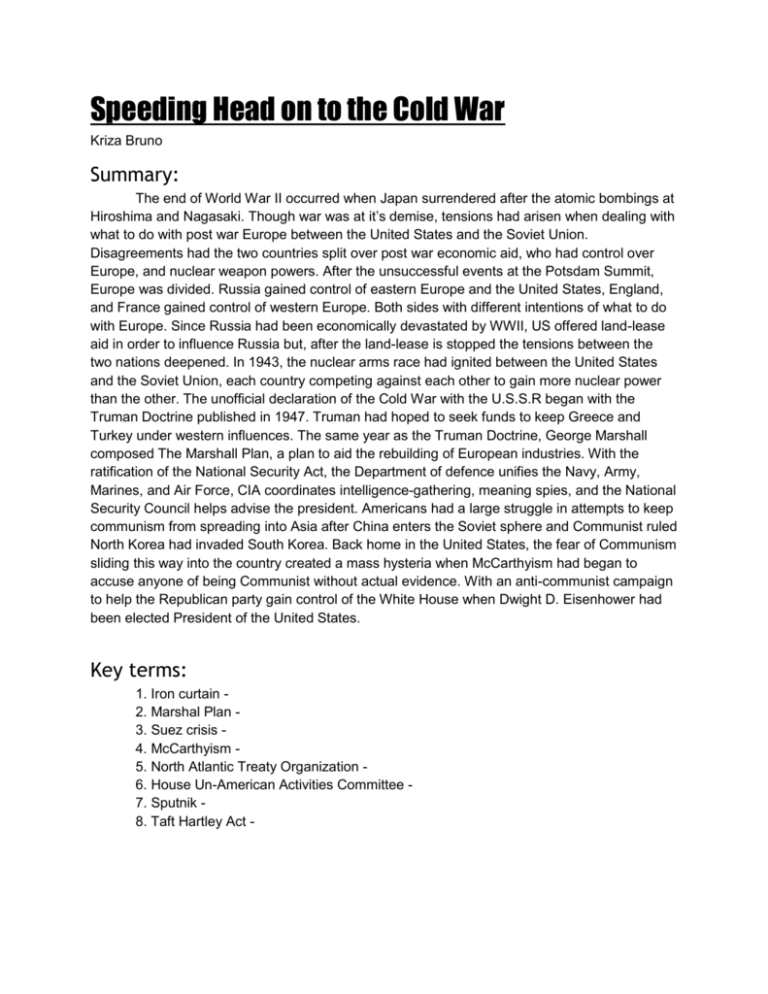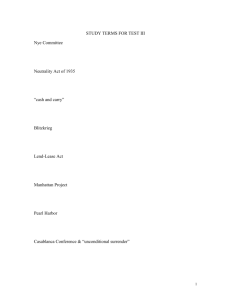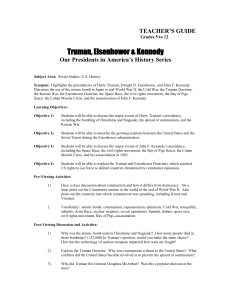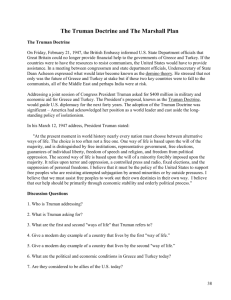
Speeding Head on to the Cold War
Kriza Bruno
Summary:
The end of World War II occurred when Japan surrendered after the atomic bombings at
Hiroshima and Nagasaki. Though war was at it’s demise, tensions had arisen when dealing with
what to do with post war Europe between the United States and the Soviet Union.
Disagreements had the two countries split over post war economic aid, who had control over
Europe, and nuclear weapon powers. After the unsuccessful events at the Potsdam Summit,
Europe was divided. Russia gained control of eastern Europe and the United States, England,
and France gained control of western Europe. Both sides with different intentions of what to do
with Europe. Since Russia had been economically devastated by WWII, US offered land-lease
aid in order to influence Russia but, after the land-lease is stopped the tensions between the
two nations deepened. In 1943, the nuclear arms race had ignited between the United States
and the Soviet Union, each country competing against each other to gain more nuclear power
than the other. The unofficial declaration of the Cold War with the U.S.S.R began with the
Truman Doctrine published in 1947. Truman had hoped to seek funds to keep Greece and
Turkey under western influences. The same year as the Truman Doctrine, George Marshall
composed The Marshall Plan, a plan to aid the rebuilding of European industries. With the
ratification of the National Security Act, the Department of defence unifies the Navy, Army,
Marines, and Air Force, CIA coordinates intelligence-gathering, meaning spies, and the National
Security Council helps advise the president. Americans had a large struggle in attempts to keep
communism from spreading into Asia after China enters the Soviet sphere and Communist ruled
North Korea had invaded South Korea. Back home in the United States, the fear of Communism
sliding this way into the country created a mass hysteria when McCarthyism had began to
accuse anyone of being Communist without actual evidence. With an anti-communist campaign
to help the Republican party gain control of the White House when Dwight D. Eisenhower had
been elected President of the United States.
Key terms:
1. Iron curtain 2. Marshal Plan 3. Suez crisis 4. McCarthyism 5. North Atlantic Treaty Organization 6. House Un-American Activities Committee 7. Sputnik 8. Taft Hartley Act -
Graphic Organizer:
United States
●
●
●
Truman follows FDR’s
New Deal economic
policies but they are
outdated.
Fear of Communism
spreads around the
nation, which
Republican’s use anticommunism
campaign to revive
their party
Arms race with Soviet
Union begins with
development of
atomic and hydrogen
bombs
Europe
●
●
●
●
●
Primary Sources:
In 1945, Russians
occupy eastern
Europe and American,
British, French troops
occupy western
Europe
U.S wants national
self-determination
throughout Europe
Russia changes
eastern Europe into
system of satellite
nations part of the
Soviet Union
Truman Doctrine
seeks funding to keep
Greece and Turkey in
western Europe
In June 1948, Stalin
starts the Berlin
Blockade.
Asia
●
●
●
●
U.S holds control over
Japan and all former
japanese territory in
the Pacific
In 1949, Mao Tsetung’s victory brings
China into the Soviet
Union
June 25,1950Communist North
Korean troops invade
into U.S influenced
South Korea.
United Nations help
with South Korea’s
defence
A. Stuttgart--Before and After the Marshall Plan
When World War II ended in May 1945, Europe was in ruins. Once-fertile fields were scarred by bomb
craters and tank tracks. In cities, seas of rubble--an estimated 500 million cubic tons of it in Germany
alone--surrounded abandoned, gutted buildings. With factories and businesses destroyed, many
people were unemployed. Food was so scarce that millions were on the verge of starvation.
These photographs of Stuttgart, Germany, taken only eight years apart, demonstrate the destruction
that existed throughout Europe at the end of the war and how Marshall Plan aid promoted rapid
rebuilding. They appear in a booklet intended to inform the American public of Germany's gratitude for
U.S. aid and the German government's decision to establish a fund as a memorial to the Marshall
Plan, the German Marshall Fund of the United States, on the twenty-fifth anniversary of the plan.
The Marshall Plan and the Future of U.S.-European Relations.
New York: German Information Center, 1973, pp. 46-47. General Collections.
Used by permission of the German Information Center.
All rights reserved. (13)
B. Dwight D, Eisenhower Farewell Address - January 17, 1961
But each proposal must be weighed in light of a broader consideration; the need to maintain
balance in and among national programs – balance between the private and the public
economy, balance between the cost and hoped for advantages – balance between the clearly
necessary and the comfortably desirable; balance between our essential requirements as a
nation and the duties imposed by the nation upon the individual; balance between the actions of
the moment and the national welfare of the future. Good judgment seeks balance and progress;
lack of it eventually finds imbalance and frustration.
The record of many decades stands as proof that our people and their Government have, in the
main, understood these truths and have responded to them well in the face of threat and stress.
But threats, new in kind or degree, constantly arise.
Of these, I mention two only.
A vital element in keeping the peace is our military establishment. Our arms must be mighty,
ready for instant action, so that no potential aggressor may be tempted to risk his own
destruction.
Our military organization today bears little relation to that known by any of my predecessors in
peacetime, or indeed by the fighting men of World War II or Korea.
C. However, we’ve been pretty successful in keeping American
newspapermen out of China
D. You read books, eh?
DBQ Question: Analyze and Contrast the Truman administration and the
Eisenhower administration. What are the successes and drawbacks of each
president during their terms in office?
Multiple Choice:
1
What was Truman’s response to the Berlin Blockade?
2
3
4
5
6
a use military force to break the blockade of land routes into Berlin
b airlift all necessary supplies into Berlin for almost a year.
c give up plans for uniting the three Western zones of Germany.
d abandon the Western-occupied portions of Berlin.
The Civil Rights Act of 1957?
a empowered federal officials to register blacks to vote.
b overturned the doctrine of "separate but equal" in education
c was opposed by President Eisenhower because he believed one couldn't change
the hearts of men with laws.
d established a permanent commission on civil rights with broad investigatory
powers.
In his farewell address in January 1961, President Eisenhower warned Americans
against?
a the influence of the military-industrial complex.
b the rise of military pacifism
c the risk of creeping socialism.
d the tendency to hysterical anti-communism.
The House Un-American Activities Committee was?
a responsible for a series of highly publicized hearings designed to expose
communist influence in American life
b declared by the Supreme Court to be in violation of basic civil liberties and
therefore unconstitutional
c the name that Senator Joseph McCarthy gave to the House Armed Services
Committee
d shut down by President Truman as a signal to the nation that the crusade against
communist subversion would be directed from the White House.
The Truman Doctrine and the Marshall Plan represented attempts by the United States
to deal with the?
a national debt
b President’s political opposition
c spread of communism
d arms race
The Korean War and the Persian Gulf War were similar in that both?
a brought about lasting solutions to problems in each region
b involved unilateral military action by the United States
c were military defeats for the United Nations
d represented United Nations efforts to assist nations in repelling aggressors
Answer Page
Key terms:
1. Iron curtain - Term told by Winston Churchill to describe what Stalin had done to
separate Eastern Europe to Western Europe.
2. Marshall Plan - The plan created by George Marshall to aid Europe economically
after World War II.
3. Suez crisis - England and France had launched an invasion in Egypt when the
president of Egypt gained control of the Suez canal in 1956.
4. McCarthyism - Red scare craze in the United States when Joseph McCarthy would
accuse people of being communist without any proper evidence.
5. North Atlantic Treaty Organization - NATO is a military defence pact between the
United States, Canada, and 10 European countries.
6. House Un-American Activities Committee - Congressional committee that helped
uncover and punish those who sided with communism in the United States.
7. Sputnik - First man made satellite to be launched into space to orbit the earth, done
by the Soviet Union.
8. Taft Hartley Act - Law in 1947 that didn’t allow unions to have secondary boycotts
and allowed the president to find ways to prevent strikes that would create damage to
the national security.
DBQ Answer:
The best way to answer the dbq question is by first understanding the question. It asks
to what were the successes and drawbacks of each president during the early stages of the cold
war. To keep the essay organized separate the answer. In one paragraph focus on President
Harry S. Truman and use document A as evidence of one of his successes and document D as
a drawback to the United States during his time in office. Then in the other paragraph focus on
President Dwight D. Eisenhower using documents B and C for his successes and drawbacks.
MC Answers:
1
2
3
4
5
6
B. Truman’s response to the Berlin Blockade was to airlift all necessary supplies into
Berlin for almost a year.
D. The Civil Rights Act of 1957 established a permanent commission on civil rights with
broad investigatory powers.
A. President Eisenhower warned Americans against the influence of the militaryindustrial complex.
A. The House Un-American Activities Committee was responsible for a series of highly
publicized hearings designed to expose communist influence in American life.
C. The Truman Doctrine and Marshall Plan deal with the spread of communism.
D. The Korean and Persian Gulf War both represented United Nations efforts to assist
nations in repelling aggressors












